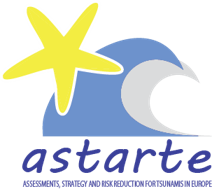Research and development
Recovery and Resilience Plan
- IPMA - PRR
- C5 - Investimento e Inovação
- C8 - Florestas
- C10 - Mar
- C16 - Empresas 4.0
- C19 - Administração Pública digital
- C21 - REPowerEU
Featured projects
Research Areas
Scientific Council
EEAGRANTS projects
MAR 2020
Grants
Geophysics - Detalhe do projecto
ASTARTE
| Project Name | Assessment, STrategy And Risk Reduction for Tsunamis in Europe |  |
|---|---|---|
| Funding entity | EC FP7 Programme, Coasts at threat in Europe: tsunamis and climate-related risks, Grant Agreement No.: 603839 | |
| Project leader | IPMA | |
| Project manager | Maria Ana Viana Baptista | |
| Description | The NEAM (North East Atlantic, Mediterranean and Adjacent Seas) region of IOC/UNESCO is known to be exposed to tsunamis and, like other regions of the world, faces increasing levels of risk due to i) continuous development of coastal areas with critical infrastructure, and ii) year-round presence of millions of tourists. In recent years, European researchers have greatly advanced knowledge of tsunami hazards and
implementation of operational infrastructure, such as creation of a regional system of candidate
tsunami-watch providers (CTWP) and national tsunami warning centers (NTWC). However, significant
gaps remain and more effort is needed.
ASTARTE will also provide i) guidelines for tsunami Eurocodes,ii) better tools for forecast and
warning for CTWPs and NTWCs, and iii) guidelines for decision makers to increase sustainability and
resilience of coastal communities. In summary, ASTARTE will develop basic scientific and technical
elements allowing for a significant enhancement of the Tsunami Warning System in the NEAM region in
terms of monitoring, early warning and forecast, governance and resilience.
| |
| Start date | 2014-01-24 | |
| End date | 2016-11-30 | |
| External Links | ||

